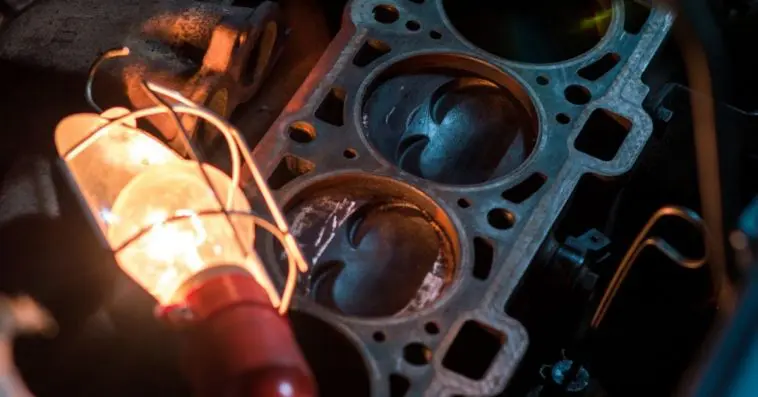A head gasket replacement is one of the costliest repairs in a car and can cost you on the upwards of thousands of dollars.
But the good news is that you can repair it at least temporarily until you save the money necessary for the fix or a new car.
Here’s everything you need to know about how to fix a blown head gasket without replacing it.
The sound substitute for replacing your head gasket is to use a head gasket sealant.
Once your head gasket is blown, you pretty much do not have any other option other than to replace or to use a sealant.
The sealant is cost-effective and gives you a few more months or can go for a lifetime depending on the leak.
Though the process of sealing is the same for all products, not all sealants work for every coolant.
It also differs based on the material and also the fuel. The right formula can give you a fix that lasts longer than the head gasket itself.
TABLE OF CONTENTS
Head Gasket Repair With A Sealant
Replacement seems to be the only solution to a blown gasket problem but not everyone wants to spend money on a gasket when your car is aging and is on the brink of giving up.
The first option should be a gasket sealer, which is quite inexpensive and saves you thousands since replacing the gasket costs you $1200 and more.
Gasket sealers are impressive in the sense that they create a seal that lasts a lifetime. Most of them are not a temporary fix for just a few miles, they can last until you decide to switch up cars.
They are cutting edge formulas that contain gasket sealing particles suspended in a sodium silicate sealing liquid bolstered with carbon fiber.
Gasket sealers take into account different factors such as the make and model of the car, coolants, anti-freeze, and more.
Hence, they can be trusted with most vehicles, either gasoline or diesel. They are also quick and give your car another lease of life.
How Does Gasket Sealer Work?
The most famous sealing method is by using a liquid sealant in the cooling system.
After adding it drive the car for about 30 minutes; this helps the sealant to circulate through the engine and identify the leak.
Depending on the product, the seal can either be permanent or temporary to carry on, until you fix the leak.
The sealant acts from the inside the cooling system and accumulates at the leaking spot. The chemicals present work by responding to the heat.
They solidify when exposed to the combustion gases. The heat of the engine then cures and strengthens the seal to complete the repair.
How Do I Use A Gasket Sealers?
Sealants may wear out over time however great they were once applied. This happens with products that are incompetent to hold the fix.
That’s why it is important to select your gasket sealer with care and strictly follow the instructions as mentioned.
While most of the sealers work universally, note if they are compatible with your antifreeze and coolant.
Another point to note is if the product works with all engine blocks (aluminum, cast iron, brass) and cylinder heads.
Few also require you to remove the thermostat or remove all the coolants from the cooling system.
Once you have chosen an appropriate gasket sealer, follow the below directions for effective sealing:
- Shake the bottle to ensure that the product is mixed thoroughly without any sediments.
- Flush the radiator with a flushing agent; in the absence of one, you can also use distilled water. Keep going until the liquid comes clean. This step is recommended but is optional. However, if your radiator is dirty, it is mandatory to flush before applying the sealant.
- Fill the radiator with water leaving enough space for the sealant. Ensure that you know beforehand the amount of product you need to use since it differs for depending on the number of cylinders.
- Add in the recommended amount of sealant and start the car. Turn the heat on, set it to the maximum, and idle it for 15-30 minutes. Set the fan on high. 9 Follow the instructions on the product.
- If your car is roadworthy, drive it at freeway speeds for about 5 miles and then turn off the engine.
- If you carried out the sealing with water, drain it and replace it with coolant.
How Do I Choose An Appropriate Sealant?
As established a head gasket sealer is probably one of the cheapest and time-sensitive products that you can buy online. It saves you thousands of dollars in car repair.
The correct sealant can hold the repair for a long time even until you decide to change your vehicle. But it all depends on the leak if it is minor or major.
Sealants can hold minor cracks and prevent any serious ones from happening.
For this, the product that you use should be of professional grade. You just cannot buy the first one that you come across.
Here are a few questions you should seek answers to if you are looking for a long-lasting sealant:
How Easy Is It To Use?
Coming to the head gasket sealer, there are quite a lot of formulations in the market. While the liquid form is the most popular, there are aerosol sprays also.
Few are just pour and go products while others require you to take precautions beforehand. If your sealant is all about pour and go, does it work effectively in sealing the leaks?
Few products require you to prep your engine and cooling system beforehand. If so, how easy is it? Can you do them yourselves or do you have to seek help from a professional?
They ask you to flush the system of coolants and antifreeze. You can add them later after the sealing process is complete.
Is It Compatible With Your Engine?
The primary step to choosing a sealant is one that suits your car. There are products designed specifically for gas engines and others for diesel engines.
Some might work only with a water-based cooling system and require you to drain and flush the system first.
An incompatible product can make things worse rather than getting the job done.
Before buying a sealer, don’t forget to read the instructions; You might have to purchase more than one bottle depending on the model of your car. The quantity hinges on the number of cylinders.
Is it Multipurpose?
Is your head gasket the only problem or do your any other leaks in your car? If a blown/leaky head gasket the only problem, you can find a product designed especially for the same.
However, if you have other leaks or engine issues, you might want to look into multi-purpose products.
These multi-purpose products work on the other issues related to the engine block, cylinder head, radiator, and cooling system.
You can get multiple jobs done with one product and saving money rather than spending money on every issue.
How Fast Does It Work?
If you are in a hurry, you’d want to get the job done, seal the leak and get back on the road.
Yes, you can get products that work that quickly too, but how good are they? It’s of no use, having to fix the leak only to have it pop up again soon.
Most sealants take one hour to two hours approximately to complete the sealing process.
Wouldn’t you rather wait and get a permanent fix rather than one that lasts for a short time period? So, choose a product depending on the time you can spare.
Permanent Fix Or Temporary Fix?
The permanency of the fix is also crucial when choosing a gasket sealer.
As said above, you’ll want a fix that works permanently. There’d no point in choosing a product that works only for the time being.
It’s important to remember that with the head gasket being hidden away from view, you cannot spot issues visually.
When issues crop up, it has already sprung a leak and the engine is starting to get hammered.
However, if you are indeed planning on a temporary fix while waiting to get your head gasket replaced, you might want to choose one accordingly.
How Can I Prevent A Blown Head Gasket?
As I repeatedly keep mentioning, head gasket repair is an expensive, labor-intensive work and costs around $1000-$2000.
The part itself is not that expensive, but the cost comes from the labor which includes dismantling the engine and rebuilding it.
It can take a few days to weeks depending on how busy the auto repair shop is.
Considering the above, it is important that you prevent such issues from happening so that you do not have to deal with the related costs.
Truthfully, however, permanent a gasket sealer is, it will wear down the line and you will face a replacement or consider the car totaled.
Here are a few pointers to help you prevent blown head gasket, stop leak, etc.
- Get your car checked at an auto repair shop or a mechanic if your car overheats too often.
A red in the temperature gauge means that your car is hitting high on the engine temperatures. If this keeps continuing, the head gasket is sure to blow, unable to handle the heat. - Check the owner’s manual for the kind of oil and coolant that you should use. Follow the directions and use the appropriate one for your vehicle. The right kind will extend the life of the car and keep the internal parts working. Also, look out for leaks.
- Another point to look out for is an engine misfire. In case your engine misfires, get your mechanic to check your car.
It is another major cause of blown head gasket since it wears down the part rather quickly. - Oil changes are recommended for a purpose. Do not miss it for any reason. Many prefer to let this slide as long as they possibly can but a dirty engine oil can adversely affect the head gasket causing it to blow.
Look through the owner’s manual for the prescribed oil change and follow it accordingly.
FAQs
Q1. Is A Blown Head Gasket The End Of My Car?
A blown head gasket shouldn’t be the end of your car if you identify the issue at an early stage.
Rather than the gasket itself, it is the damage to other parts like non-lubrication, overheating, and leaking coolants, that are worrying.
If you spot the issue at an early stage and use a sealant to seal the leak, you should be good to go at least until you get the part replaced.
Q2. Can I Use The Head Gasket Sealer More Than Once?
Yes, you can use a head gasket sealer more than once, if your head gasket has sprung a leak again.
Ensure that you flush the remaining sealer from the system lest it clogs the radiator and the thermostat.
But, if the leak is bad that you have to seal it repeatedly, you should probably look into replacing it.
Q3. What Are The Symptoms Of A Blown Head Gasket?
A leaky head gasket is not easy to locate, but if you know the indicators, you can easily spot the blown one. The following are symptoms of a blown head gasket.
- Overheated engine
- Reduced coolant in the system
- Milky engine oil
- White smoke from the exhaust pipe
Conclusion
A blown head gasket is a tricky issue to deal with. It is a labor-intensive task that leads to thousands of repairing such that it is the fourth expensive repair in a car.
In case replacement is not possible, the best alternative is to use a gasket sealer.
Gasket sealer is a liquid sealant that when poured in the radiator transports through the cooling system and sealing the leaks in the head gasket.
They seal by reacting to the gases and curing with the engine heat further strengthening the fix.
As with all purchases, you need to consider certain factors before choosing a sealant. The ease of use, compatibility, functionality, permanency, etc, play an important part in deciding on a product.
But if the issue continues, you might want to consider replacing the head gasket.




